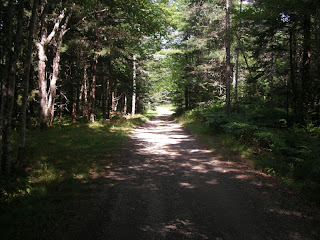The Stehelin family entertained people from all over and the community was a blend of French European, Mi'Kmaq, Acadien and African peoples.
The picture above is the entrance. The trails are accessible to bicycles but better on foot, as the ruins are overgrown on the sides of the roadway. It is not wheelchair accessible, unless you have an off-road one. There are picnic tables and overturned garbage cans in the grass parking lot near the entrance.
This is the initial pathway and reflects the general state of the area. The main industry here, as it is now is logging. One of the two main reasons it was abandoned was the desire for the male children to seek out life outside the community. The other, and most important one, was the sudden decrease in the price of logs. There was also a fire that burned a portion of the railway that was built by the family to ship logs to nearby Weymouth.
After the site was abandoned by the family, the buildings fell into disrepair and were looted and vandalized often. There were reports of spirits and ghosts in the area but this was mostly hearsay. In the 1950's, a paper company tore down all the structures. You can see some ruins here. It looked like there were actual signs (or at least posts to put up signs) here and there to describe buildings and sites of interest but there are not. We used a book written by Paul H Stehelim (although ours had a newer cover) as a guide, as there is a handy map inside.
Here is the wine cellar. They were aristocratic after all.
I like the solidity of the foundations at the same time as the raw power of nature.
Another view of the wine cellar.
Here is a view of the magnificent lake.
Another lovely view. I can see why they picked this spot. The site was bought by Irving but now is owned by the province of Nova Scotia.
This is the big house where the family slept. They had servants who were schooled in the European way of things.
Another view of the big house.
And another.
These were some smaller buildings as seen from the road. As you can see it does take some careful looking to notice them if you aren't paying attention.
The foundations of a large building.
This is the river bed that would have housed the mill and powerhouse.
An old bridge that is falling into disrepair. Please excuse the blurriness of the photo.
Just after the bridge is a walking path that takes you near the casino would be. It was not a place of gambling but rather the classic use of the word for a place of relaxation. Here it was a beach house that also stored the sailboat and iceboat. If you don't want to take this nice meandering path, the roadway is just up the hill and on the right.
A picture taken on the pathway.
This is the sand on the beach. Very coarse and contains lots of quartz.
This is a view on the beach towards where the New France community would be. A person canoing on the lake would never know it today.
Somewhere around here would be the casino. It is used as a campsite but is quite messy with some garbage and camp stove propane tanks here and there. Hopefully the province tidies up the site and places sign-age on the bare poles that were made for them.
Another view of the lake. I like the tall trees on the island. Its just begging to be rowed out to.
This is the pathway on the way back from the beach. There were frogs that jumped in the various pools as we were walking out.
All in all an interesting and forgotten area in Nova Scotia history. An interesting site with pictures of the structures as they were is here. For modelling, its good to see the ruins of buildings for terrain making purposes. It inspires and gives ideas.
UPDATE: I received an email from Harold Carroll, the Nova Scotia Department of Natural Resources Director of Parks and Recreation:
"Thank you for the information. When the province acquired the lands in question it did so as a means to protect the heritage aspect with the understanding that no resources were available to provide any maintenance and or improvements to the site. Local people are from time to time removing some of the garbage on a volunteer basis and we greatly appreciate that help. Interpretive signs did exist but were removed by the previous landowner as they were their property and not suitable for posting under a new landowner.
There are no plans for the area at this time."
Its unfortunate that the signs that were there by Irving could not be kept, with stickers on top of the Irving signs. I'll try to see if they can donate them back.
UPDATE 2: I emailed Irving the above email and its been forwarded to the VP of Communications. Here's hoping for signage!
UPDATE 2: I emailed Irving the above email and its been forwarded to the VP of Communications. Here's hoping for signage!




























No comments:
Post a Comment